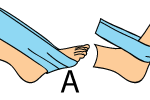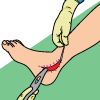What is Tarsal Tunnel Syndrome?
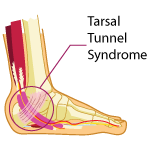 Tarsal Tunnel Syndrome occurs when there is pressure on the posterior tibial nerve, causing pain below the inside portion of the ankle bone. This pain will also be present in the arch of the foot, and it may be accompanied by a burning sensation.
Tarsal Tunnel Syndrome occurs when there is pressure on the posterior tibial nerve, causing pain below the inside portion of the ankle bone. This pain will also be present in the arch of the foot, and it may be accompanied by a burning sensation.
It’s called Tarsal Tunnel Syndrome because the area where the posterior tibial nerve is compressed and causing pain is the portion that is inside a structure called the “Tarsal Tunnel”.
Causes
Pressure on the posterior tibial nerve is caused by swelling in the area, which may be the result of a soft tissue injury, a medical condition, or biomechanical issues with the foot. These include:
- Sprained Ankle
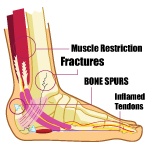
- Diabetes
- Osteoarthritis
- Rheumatoid Arthritis
- Ganglion Cyst
- Varicose Veins
- Flat Feet
- High Arches
Signs & Symptoms
Tarsal Tunnel Syndrome is often misdiagnosed as Plantar Fasciitis because the symptoms of very similar. Signs and symptoms of Tarsal Tunnel Syndrome include: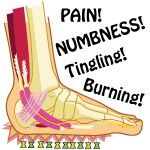
- Shooting pain in the arch and heel areas
- Burning pain
- Numbness and tingling in the bottom of the foot
- Pain that worsens at night
- Pain that worsens during activity
- Tenderness below inside portion of ankle bone
Treatment Options
Treat your Tarsal Tunnel Syndrome based on the cause, and this should help decrease your symptoms. Since the root cause of Tarsal Tunnel Syndrome is swelling that causes compression on the posterior tibial nerve, relieving this swelling should be the first step.
The RICE method consists of Rest, Ice, Compression & Elevation. Rest will help you avoid further pain and aggravation. Ice and Compression work together to relieve the swelling and pain. Elevating your foot above your heart will bring down the internal inflammation.
Taking an NSAID (non-steroidal anti-inflammatory drug) like Advil or Aleve will alleviate pain as well as inflammation. This may help you sleep better if the pain is especially bad at night. Just make sure you don’t take NSAIDs if you’re going to be active or on your feet a lot during the day, because they completely block the pain signal, making you unaware of any further damage you may be doing to your ankle and/or foot (if your Tarsal Tunnel Syndrome is related to any type of soft tissue injury).
If your Tarsal Tunnel Syndrome has been brought on by a biomechanical issue like flat feet or high arches, physical therapy can help you manage this. There are exercises you can do to help with strength, flexibility and range of motion.
Sometimes, conditions like Tarsal Tunnel Syndrome can be linked to something as simple as improper footwear. Make sure your shoes are the correct size. If they’re worn out, invest in a new pair. Make sure they are comfortable and provide support. Avoid wearing high heels.
If conservative treatment methods have failed to help, cortisone shots can be administered to temporarily relieve pain and swelling. It should be noted, however, that you shouldn’t have more than 3-4 cortisone injections into a given area in a year. There are a variety of side effects and risks associated with continued use of cortisone shots, such as bone death, tendon rupture, skin discoloration and nerve damage.
Surgical intervention should be your absolute last resort. Surgery should only be considered if you’ve had Tarsal Tunnel Syndrome for several months and have achieved no success with conservative treatments. Information on the outcome of surgery for people with Tarsal Tunnel Syndrome is mixed.


